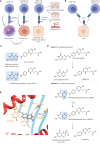MR1-dependence of unmetabolized folic acid side-effects
- PMID: 36016938
- PMCID: PMC9395688
- DOI: 10.3389/fimmu.2022.946713
MR1-dependence of unmetabolized folic acid side-effects
Abstract
The fortification of flour with folic acid for the prevention of neural tube defects (NTD) is currently mandated in over eighty countries worldwide, hence compelling its consumption by the greater part of the world's population. Notwithstanding its beneficial impact on rates of NTD, pervasive folic acid supplementation has invariably led to additive daily intakes reaching well beyond their original target, resulting in the circulation of unmetabolized folic acid. Associated idiopathic side-effects ranging from allergies to cancer have been suggested, albeit inconclusively. Herein, we hypothesize that their inconsistent detection and elusive etiology are linked to the in vivo generation of the immunosuppressive folic acid metabolite 6-formylpterin, which interferes with the still emerging and varied functions of Major Histocompatibility Complex-related molecule 1 (MR1)-restricted T cells. Accordingly, we predict that fortification-related adverse health outcomes can be eliminated by substituting folic acid with the bioequivalent folate vitamer 5-methyltetrahydrofolate, which does not break down into 6-formylpterin.
Keywords: MAIT cell; MR1; folate; folic acid (B9); unmetabolized folic acid.
Copyright © 2022 Tang, Cait, White, Arabshahi, O’Sullivan and Gasser.
Conflict of interest statement
The authors declare that the research was conducted in the absence of any commercial or financial relationships that could be construed as a potential conflict of interest.
Figures


Similar articles
-
Folic acid fortification prevents neural tube defects and may also reduce cancer risks.Acta Paediatr. 2012 Oct;101(10):1007-12. doi: 10.1111/j.1651-2227.2012.02781.x. Epub 2012 Jul 24. Acta Paediatr. 2012. PMID: 22783992
-
Fortification of flour with folic acid.Food Nutr Bull. 2010 Mar;31(1 Suppl):S22-35. doi: 10.1177/15648265100311S103. Food Nutr Bull. 2010. PMID: 20629350 Review.
-
Effectiveness of Folic Acid Fortified Flour for Prevention of Neural Tube Defects in a High Risk Region.Nutrients. 2016 Mar 9;8(3):152. doi: 10.3390/nu8030152. Nutrients. 2016. PMID: 27005659 Free PMC article. Clinical Trial.
-
Not all cases of neural-tube defect can be prevented by increasing the intake of folic acid.Br J Nutr. 2009 Jul;102(2):173-80. doi: 10.1017/S0007114508149200. Epub 2008 Dec 16. Br J Nutr. 2009. PMID: 19079944 Review.
-
Unmetabolized folic acid in serum: acute studies in subjects consuming fortified food and supplements.Am J Clin Nutr. 1997 Jun;65(6):1790-5. doi: 10.1093/ajcn/65.6.1790. Am J Clin Nutr. 1997. PMID: 9174474 Clinical Trial.
Cited by
-
Effects of folic acid supplementation in pregnant mice on glucose metabolism disorders in male offspring induced by lipopolysaccharide exposure during pregnancy.Sci Rep. 2023 May 17;13(1):7984. doi: 10.1038/s41598-023-31690-w. Sci Rep. 2023. PMID: 37198280 Free PMC article.
-
Effect of Unmetabolized Folic Acid on Immunoinflammatory Markers in Sickle Cell Disease Patients Taking Folic Acid Supplementation.Indian J Clin Biochem. 2024 Oct;39(4):557-564. doi: 10.1007/s12291-024-01204-0. Epub 2024 Mar 20. Indian J Clin Biochem. 2024. PMID: 39346717
References
Publication types
MeSH terms
Substances
LinkOut - more resources
Full Text Sources
Medical

